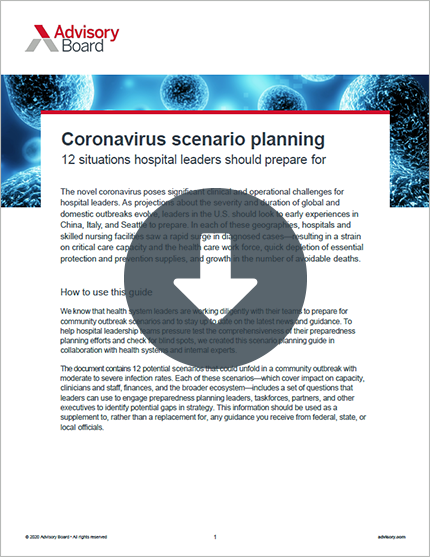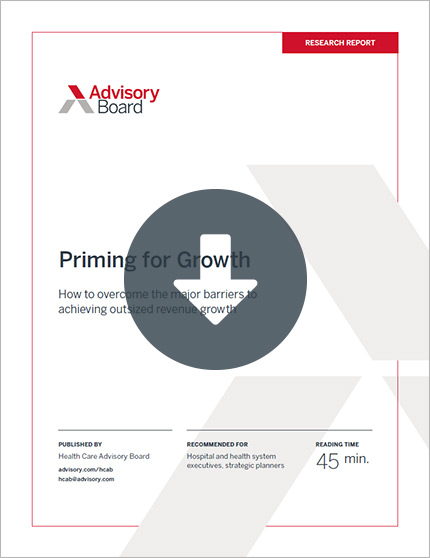Auto logout in seconds.
Continue LogoutWelcome to the "Lessons from the C-suite" series, featuring Advisory Board President Eric Larsen's conversations with the most influential leaders in health care.
In this edition, Dr. Gianrico Farrugia, president and CEO of Mayo Clinic, talks about investing in Covid-19 research—including four vaccines in development—while weathering the financial storm of the crisis; why health organizations have "a moral obligation" to transform health care from within; and how Covid-19 accelerated Mayo's strategic vision for the future.
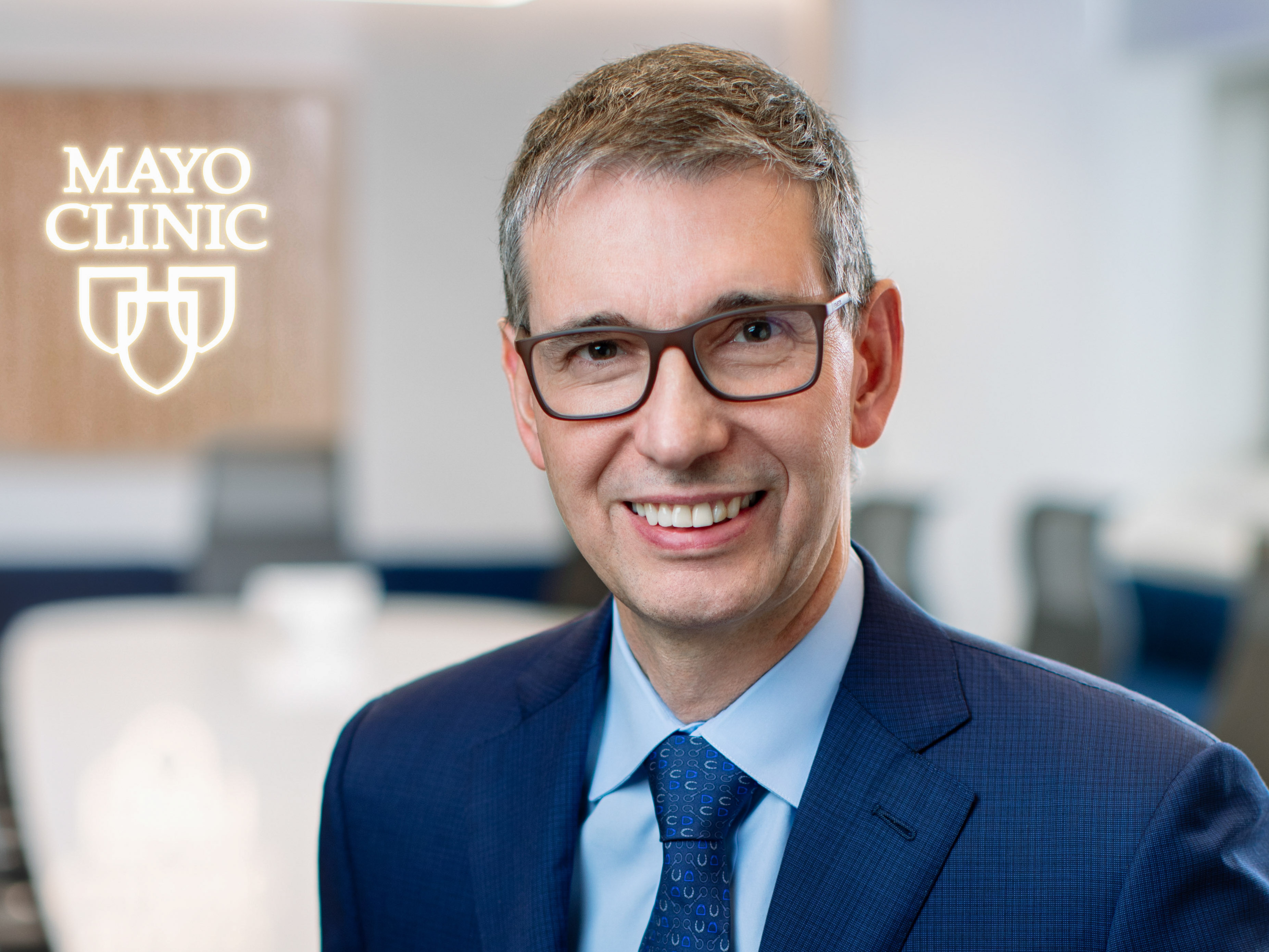
Question: Gianrico, there's much I want to talk with you about, but it would be irresponsible not to start by asking about Covid-19; economically, emotionally, and in terms of lives lost, this has been a cataclysm across the globe, and certainly our industry hasn't been spared. Mayo Clinic, of course, entered the crisis in a formidably strong financial position—$13.9 billion in revenue last year, $1 billion in net income—but even Mayo hasn't been immune to the financial devastation. What has been your experience so far?
Gianrico Farrugia: Eric, you're exactly right. Covid-19 was certainly a stress test on health care, and it's a stress test that has highlighted all the systemic flaws that we've been talking about for many years: fragmentation, inability to seamlessly transfer information between health centers, how hard it is to know exactly what's going on as a country versus as an individual health system.
So, from a Mayo Clinic standpoint, we've been focused on three things. First, how do we uphold our mission to ensure people and patients who have complex and/or serious disease continue having access to Mayo during the pandemic? That required us to rebuild the practice in a way that allowed us to do much more telehealth. We realized very quickly that sickness doesn't pay much attention to pandemics, and people who had to delay care were getting sicker and needed to come to see us. So, we had to adjust for that.
Financially, we first did what everybody else does—looked at ways to cut expenses—but that wasn't enough. We made hard decisions about furloughs and introduced a hiring freeze until we could get into a better position. However, we started off in a very strong position that allowed us to go deeply into our reserves, which we could tolerate because of all the years of significant investment that Mayo has made into building those reserves.
Luckily, the cuts were shorter lived than we projected. The hard work, flexibility, sacrifice of our entire staff—and above all, their commitment to the needs and safety of our patients—resulted in our practice activation moving much quicker than we expected. And we exceeded expectations for revised 2020 patient volumes and financial targets. We are in a much better position than we anticipated, and we recently were very pleased to be able to restore pay and end furloughs early.
Q: Given the singular position of Mayo in the industry, you're at the forefront of innovation in advancing research across multiple domains—convalescent plasma, antigen and serologic testing, studies around antiviral treatments, to name just a few. I know our readership will be interested to hear how things are progressing on these fronts.
Farrugia: That actually speaks to the second thing we've been focusing on, Eric. Because fundamentally, this crisis made us realize that this is exactly the right time to make sure we remain true to our values. That includes ensuring that we're there for the people who need us and contributing to the national response.
Therefore, as an organization committed clinical care, research, and education, we decided to invest more in research, especially around Covid-19, despite the challenges. And we very quickly saw early results, like novel testing. We now have several tests—molecular, serology, neutralizing antibody, and many other variations. Building on Mayo's culture of collaboration and innovation, in mid-March we set up a research task force for SARS-CoV-2 and Covid-19 to coordinate all of Mayo Clinic's pandemic-related research activities. It's made up of 16 independent, multidisciplinary teams led by domain experts across the Mayo Clinic enterprise—areas such as clinical trials, biobank, virology, vaccine development, genetics, data science, artificial intelligence (AI), and how Covid-19 affects different ethnic populations and pediatric patients. As one of many results, we currently have four vaccines under development.
And this also made us ask ourselves, "How do you integrate what's happening at the national level into what's happening to Mayo Clinic? How can you feel safe coming to Mayo Clinic?" And it pushed us to broaden partnerships, including within our immediate communities, to help figure out what it means to find a safe hotel, a safe place to get food, a safe way to travel. We were also able to quickly research and test how airflow will need to work in the operating room; how to bring people safely through the front door, test them, and have them safely stay in town for the duration of their care; and if they test positive, how to support them.
And all that happened in a period of several weeks, so much so that we had a ramp-up in May, and we're currently at around 85% to 90% of prior volumes across sites. And in doing that, we realized that we could also help advise corporations across the country in how they can safely reopen and re-instill confidence. We're starting in Rochester, Minnesota, partnering with our city and local businesses to ensure a safe and resilient recovery. And extending to companies such as Hilton and Delta.
Q: You mentioned three things the crisis has brought to light—what's the third?
Farrugia: It's our strategic plan, and how this crisis affects that plan.
Before Covid-19, people in the health care industry were always saying, "Yes, we know we need to go digital," but there always seemed to be a reason why we couldn't. And we, like every other organization, found that Covid-19 would sweep aside the barriers. We went from a few hundred virtual visits a week to a peak of 35,000 virtual visits a week. And while those have come down a little now, as we've balanced them out with in-person visits, it reminded us that even for somebody like me—who you perhaps think of as a little more ready to push the boundaries—we haven't been as innovative as we needed to be because of the current health care environment.
So here is an outside force that pushed us to say, "Yes, our strategic plan can be accelerated. We can cure, we can connect, we can transform health care, and we can do it in a matter of weeks and not months." And I think I'm speaking for the whole health care system when I say that, not just Mayo Clinic.
Q: Gianrico, I'd like to broaden the aperture a bit and ask about the wider implications of Covid-19 on our industry. Specifically, I'm curious for your thoughts on how quickly and robustly non-emergent volumes will return. When I ask this question of your counterpart CEOs, there seems to be an emerging optimism that we are on our way toward a structural recovery.
But we know from past economic dislocations (the Dot-com crash, 9/11, the global financial crisis of 2008), that volumes can be much slower to return than projected—in some cases, requiring a two- to three-year recovery period. And with unemployment currently at 13.7%, our level of economic displacement is even higher than during any of those other referenced periods. What are your thoughts?
Farrugia: Eric, I look at it from three separate lenses. One, do we even want to get back to pre-Covid-19 volumes? If you truly believe there's a better way of doing things—that a hybrid approach of bricks-and-mortar and digital offerings to care for patients could be better than what we have now, and that, indeed, there's undeniable waste in the current health care system—then the question is, "Do we have an opportunity here to create a new health care system that doesn't necessarily need to reflect the old volumes?"
If the number one priority is deciding what the new normal should be, then number two is actually creating a mechanism so that it isn't easy to go back to only face-to-face visits and old models. Because, if we look closely at what happened to those volumes, you'll see it was a mix of people being unable or unwilling to come to the hospital, yes, but also hospitals taking the carefully considered step of telling people not to come to the hospital—so it was a bit of an artificial clamp down, more severe than it would have been if the systems hadn't taken that step on their own. This means we must preserve our ability to do what we've done here on the digital front so that we can safely look after patients. We have to keep that space from shrinking or springing back to pre-Covid levels.
Number three is that with everything else happening, with all the unemployment, I do believe that the recovery is going to be much longer than the people think. And unfortunately, before Covid-19, health care economics were such that hospitals had to work at very close to capacity to survive. And with Covid-19, you can't do that because your operations take longer. So if we want to describe the recovery curve, it's unfortunate there are only 26 letters in the alphabet, because V does not describe it, U does not describe it, and we don't think it's going to be a W—it is going to be a series of recoveries and setbacks, but whatever it's going to be, we need to actually push hard for change now, because the easiest thing to do would be to go back to previous volumes.
And fundamentally, when it comes to sickness, unfortunately, nothing has changed. So, it isn't as if magically the diseases that were there three months ago have disappeared—they have been hidden, and they're going to come back. So we need to be ready to deal with them in a new way, because if we go back to the old way, not only will we have experienced a terrible pandemic, but we'll have wasted the opportunity to transform health care. I'm in no hurry to get back to 100% capacity in an old model because I believe our new capacity will be greater and it's not going to be the same 100% that it was before.
Systemness resources
Research Report
10 insights on reducing care variation
Expert Perspective
The system approach to service line management
Q: You mentioned that Covid-19 has brought to light some of the structural shortcomings in our health care system, and that spotlight may accelerate or decelerate elements of the industry's (and Mayo's) strategic decisions.
With that notion in mind, what are some of the bigger, consequential structural shifts in the health care delivery system that you are seeing? You inventoried a few of them—telehealth and virtual, as examples—but you also intimated a deeper, more profound reimaging of capacity and care delivery going forward.
Farrugia: Yes, that's right. In health care, the structural changes that need to happen are no mystery; there's nobody in health care saying, "Oh, this is something new we found out that we didn't know." No. It's really about executing on things we've known for a long time.
But what Covid-19 taught us is that health care systems need to take a leadership role. There was this notion that for true change to happen in health care, it had to come from the outside of the industry. While I never subscribed to this school of thought, Covid-19 demonstrated the opposite —that for true change to be patient-centric and long-lived, it really has to happen with health care organizations taking a leadership role, in partnership with others. And that is not a nuanced shift of perception—that's a significant change from where some systems were positioning themselves, that they'll adapt to outside disruption. But Covid-19 has convinced me even more that we have a moral obligation—as well as a path forward—to be the ones transforming health care from within.
Q: So what I'm hearing is that your 2030 strategy represents nothing short of a transformation of health care itself—and transformation from within. What does that look like in practice?
Farrugia: Mayo Clinic's 2030 strategy is really that: transforming health care from within. So yes, that's telemedicine, but that's the obvious one. More broadly, it's, "How do you provide safe care at home?" And that is really just a way of saying that we need to move away from pipeline businesses to platforms—that we need a true health care platform, and that Mayo Clinic is going to be the organization that builds this health care platform for ourselves and for others.
Data are a big component of this. Now, everyone agrees that yes, data are really important, and that we need to derive new knowledge from data. But before Covid-19, we sort of stopped there. The pandemic has clearly shown us that new knowledge without the ability to scale it into usable products for people and for our patients is useless. Health care systems can't just derive knowledge from data and stop there—that's insufficient; in fact, it's a failure. No, we now have to take that new knowledge, then partner and drive it into a new way of looking after patients. That means being able to say to people that we, together with our partners, can create an ecosystem to not only safely look after you at home for as long as possible, but also to determine, before you actually know it yourself, when it's no longer safe for you to be at home.
And this leads to two different paths: One path is that your hospital stay is not needed or much shorter, and the other is that your hospital stay is required. And both require a non-linear approach. For the former you need a platform because you need not only the health care-at-home part, but also you need food figured out, you need your laundry figured out, all of that. So that has been Mayo Clinic's push, to create a true platform around different areas, such as clinical diagnostics, remote monitoring and management, and virtual care.
Establishing Mayo as an international 'Destination Medical Center'
Q: Gianrico, let's pivot here and address Mayo's growth plan moving forward. You've described creating an expansive virtual platform for Mayo Clinic, but there is also a more conventional bricks-and-mortar expansion as well—including Mayo's well-documented "Destination Medical Center" (DMC)—a $5.6 billion, 20-year, public-private economic development initiative to support Mayo Clinic in Rochester as a global medical destination center. How does Covid-19 impact the plans for DMC, and other infrastructural investments in your other geographies, if at all?
Farrugia: I've always been a little worried when people try to imagine health care without hospitals, because, fundamentally, I believe that's unrealistic. It's an easy idea to like, but just because you like something doesn't mean it's going to happen. We're all human and unfortunately most of us will get sick at least once before we die. Therefore, any responsible health care organization needs to have both a physical and non-physical presence to balance looking after someone when they don't need to come to a destination versus when they very much do.
So we will continue developing Mayo Clinic in Rochester, Florida, Arizona, and now Abu Dhabi as DMCs. At all of our destination medical sites, we ensure that when people come, they get the highest-quality care—and also ensure that when they aren't able to come, they'll still experience that level of care. I often tell people that it's really bricks and clicks. So, it's not just bricks and mortar or just clicks—it's both bricks and clicks.
And approaching it that way will also ensure we continue to invest in the cure component of Mayo Clinic strategy. We can't just accept the fact that chronic diseases are indeed chronic—if you can cure an acute disease, why not also cure a chronic disease? I've pushed Mayo Clinic to take a leadership role in developing cures. And the way to provide more cures is not only to invest in the continuum of research in translational clinical care, but also to provide a safe place for destination care.
Q: Would you expand further on the developing international strategy of Mayo? You mentioned Abu Dhabi, where you are building Sheikh Shakhbout Medical City, and London, where have established a location along Portland Place. How do these investments fit into the "bricks and clicks" construct you described?
Farrugia: In a way, it's going back to our roots: The first Mayo was from England. And when Mayo Clinic created the first medical record, the first person ever to be registered was from Canada. And every year, Mayo sees people from all 50 states and 140 countries, while our alumni are in more than 90 countries. So, we've always had an international presence.
But we wanted to go further, and we challenged ourselves, saying "let's get laser-focused on our innovation priorities," which for us is complex and serious disease. And beyond that, how can we translate that to places outside of our U.S. presence? And that's where we decided to establish presence in London and Abu Dhabi, though with different models.
In London, we made the decision a couple of months ago that in order to focus on complex and serious diseases, it had to be Mayo-owned and we're grateful to Oxford for allowing us to work out the agreement, so that it's now wholly owned by Mayo.
And in Abu Dhabi, when we had this opportunity to run a 741-bed, 3 million square foot hospital, the first question was, "Are you going to call it Mayo Clinic?" And our answer was very simple: No, not at first. For now, it's a collaboration. It will be Mayo Clinic when it's a true DMC, when any person can feel as confident walking into that front door as they do in Rochester. And that will take several years; it will take commitment from the Mayo Clinic and from the UAE government. And that's why we have several of our people there, and that's why we're going slowly—because unless we have a Mayo culture, then nothing else will work the same way it works at other Mayo Clinic sites. Developing a Mayo Clinic culture takes time.
We also have a network of hospitals affiliated with Mayo Clinic around the globe, and we're also exploring how to knit that network more tightly to Mayo Clinic's capabilities. And our medical platform allows us to do that—anybody can innovate on our platform—but our network is very closely tied to what Mayo is.
Building a network of partnership—on a novel platform
Q: Now to the platform concept. I know, Gianrico, you've written voluminously on this—not just articles, but in fact a book on innovation. And in addition to the Mayo Clinic Care Network, which I think has 50 affiliates or members, you've also constructed some path-breaking partnerships, most prominently with Google. It is clear these are all variations on a central theme. What does it mean to invent this platform and how do you know when you've been successful?
Farrugia: Mayo works in a committee structure. And using Agile methodology, one committee came together and said, "How are we going to break the current paradigm and transform health care from within in a scalable way?" And it became clear that to do so we needed a true health care platform, a platform that wasn't simply pipes, but a platform like those outside of health care. Because in health care, there really aren't true comprehensive platforms—there are examples of bits and pieces, but not of a true multi-owner platform.
So we thought that this platform could perhaps be seeded by Mayo, and that we'd put our data on it, but we'd invite others to work with us, and eventually, that people will work together—with or without Mayo—to innovate and transform. And I think that is where the transformation of health care will come from.
To achieve that, we needed a strategic technology partner with AI expertise and cloud computing capabilities, and we chose to partner with Google. We wanted a group that was aligned with our objectives, but not so overlapped with us that they would merely be additive. We really felt Google could help us spur the transformation we wanted.
Q: That's fascinating. Can you break it down a bit further—what does it look like in practice? How does this dovetail with the partnerships you're building inside and outside the industry?
Farrugia: To make that real, we had to decide how we were going to seed it, how we're going to run it initially, and what are we going to focus on. And to build on what we've discussed earlier about data, we know we can derive much more value from data if it's more available—so that means applying new ways of deidentifying data and preventing re-identification—and then apply AI-based tools, autonomously or semi-autonomously, to better derive knowledge from that data, which then becomes a product. And because the process of converting data to knowledge is useless without products, together with virtual care, we focused initially on clinical data analytics and digital diagnostics and management.
For example, take the 12-lead EKG or single-lead EKG. We found that if you put that data out there and let people work on it, there are startling findings—like diagnosing left ventricular dysfunction five years before it becomes clinically apparent, or measuring potassium levels, or predicting who's at risk for developing atrial fibrillation. And now we can take it to the next level—we have a group assessing whether it's possible to use that sort of database, and AI mining of the data, to diagnosis Covid-19 infections from an EKG.
Q: I understand that Mayo has something on the order of 200 AI projects in flight at the moment. When I talk with your CEO counterparts there's equal part fascination and disillusionment with AI. Even among those who are incredibly well-regarded and pioneering in adapting technology to patient care delivery, their investments just can't compare with the $23 billion R&D annual budget of Amazon, or $17 billion for Google, or $13 billion for Microsoft. These trillion-dollar market cap FinTech companies have resources that we on the health care delivery side simply do not.
It sounds like Mayo is charting a pioneering sort of middle course. You're partnering where it's appropriate, but you're also orchestrating a number of experiments with AI on your own. Could you expand on how philosophically you're approaching these disruptive technologies—AI, ML, RPA?
Farrugia: To succeed, Eric, you need people, technology, and space—the platform—to bring people together. But you also need to start with a clinical need in mind; if you don't have that in mind, you'll get diluted. You'll never compete with the AI engines of the world. But if you start with a clinical need and people who want to work together on it, then it can happen. So we were very clear and said, "We're not going to compete on AI for AI's sake." Instead, we're saying, "What are we going to do to solve problems that our physicians find interesting and, more importantly, that our patients need?"
And we saw that with our partnership with Google. Google has a number of incredibly rich partners, and they can work with whomever they want to work. But when we presented use cases with a very human problem, the level of excitement in the room went beyond, "Let's mine this data set and see what we come up with." That's a useful attitude, but it doesn't give you that accelerant, the fire in the eyes, the ability to say, "Yeah, even though Mayo's culture and Google's culture are not identical, we're all working on the same problem, and that same problem has a human face, and that human face—in this case, a disease we can work on together—is why our AI approach has a better chance of success."
Wrapping up
Q: With the time we have remaining, I'd like to ask one final question. As I reflect on my two decades working with Mayo, I'm struck by just how passionate every single Mayo representative is about Mayo's mission and team-based culture. Everyone seems to have one or two profound, personal stories that encapsulate for them what Mayo means, such as when your predecessor Dr. John Noseworthy told me about his first experience with Mayo. You've been there 30 years, Gianrico—what was the singular moment for you that made it clear that this was where you wanted to dedicate your career?
Farrugia: As you know, Eric, I came from a different country (Editor's note: Malta), and I came to Mayo Clinic with an accent. I still speak way too fast, but it was harder to understand me back then. But Mayo embraced me for who I was and what I could do rather than who I appeared to be. And that was very powerful for me.
But the most powerful message for me actually came from mentors. Throughout my residency, my fellowship, my research, and my becoming a member of the staff, there was somebody better than me who was taking the time to explain to me what Mayo Clinic was and what it truly meant to look after patients. For instance, I had been at Mayo for just one year when a friend of mine sent me a brain angiogram that I didn't know what do with. So I reached out to this neurosurgeon, Thor Sundt, to take a look. He was a giant in the field who operated on our presidents, was the chair of his society, and had an entire "60 Minutes" episode focused solely on him. When I got to his office, he treated me as if I were the most respected colleague he'd ever seen. And when a giant at Mayo Clinic treated a lowly intern like me that way, I was sold.
So now I always tell people the same thing: When you come to Mayo Clinic, embrace Mayo Clinic first so you can understand it, and then change it. Don't try and change it before you embrace it, because you're not going succeed—but don't also just embrace it and not try to change it. Embrace first, change later.
Get more lessons from the C-suite
Check out Eric's recent must-read interviews with top hospital and health system leaders:
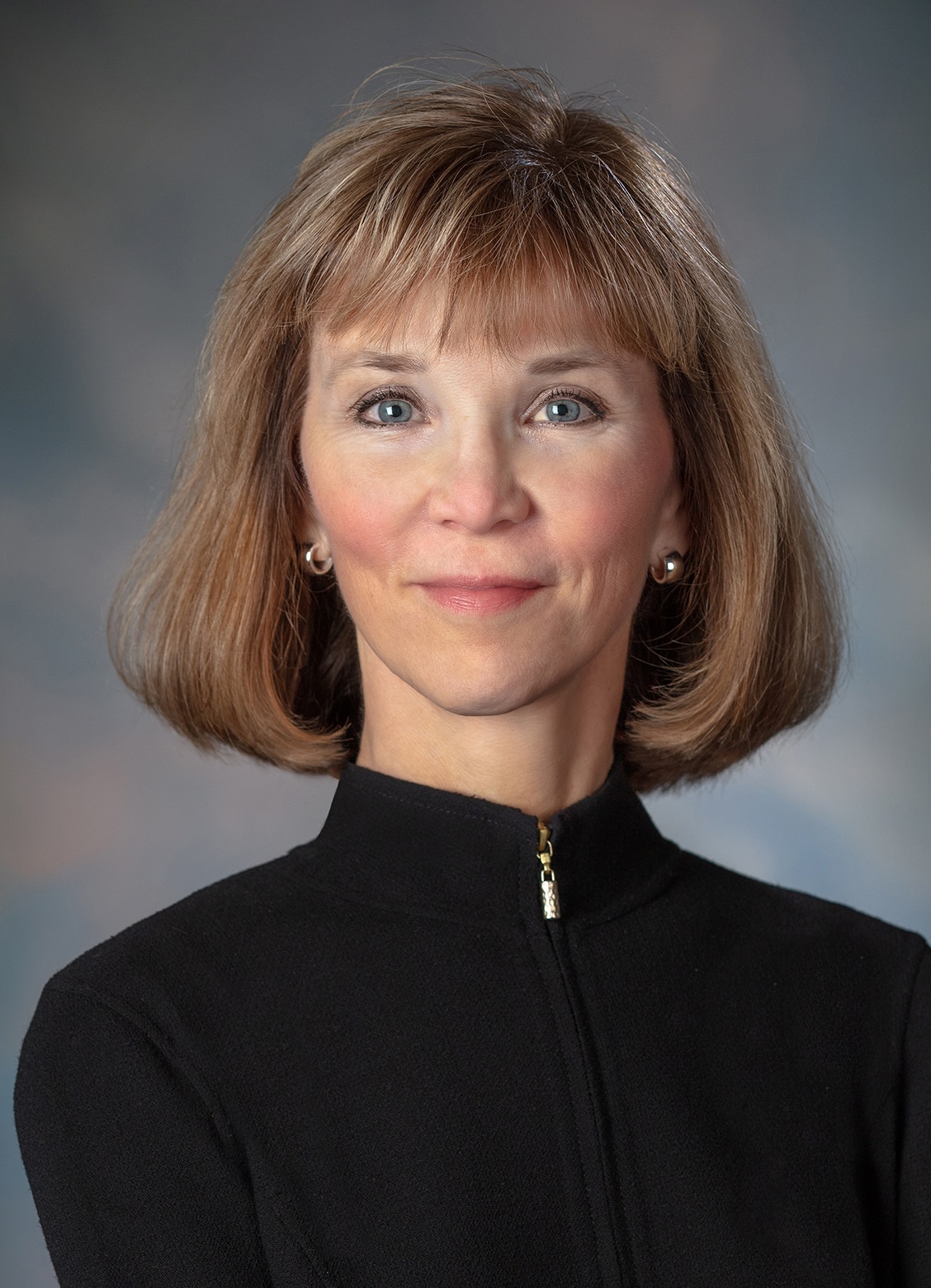 From Ascension to Intermountain and now 'home' at SSM Health: How Laura Kaiser is 'systematizing' mission-based care
From Ascension to Intermountain and now 'home' at SSM Health: How Laura Kaiser is 'systematizing' mission-based care
Laura Kaiser, president and CEO of SSM Health, talks about the call to nonprofit health care, SSM Health's legacy of caring for "Our Dear Lords," and why she's completed at least one triathlon almost every year—for the last 36 years. Read our interview with Laura.
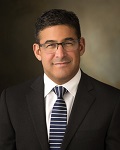 Marc Harrison promised to turn Intermountain into a 'Tesla.' He wasn't kidding.
Marc Harrison promised to turn Intermountain into a 'Tesla.' He wasn't kidding.
Marc Harrison, president and CEO of Intermountain Healthcare, talks about Intermountain's recently announced strategic reorganization, previews the launch of a ""virtual hospital"" to better serve rural communities, and shares the surprising worry that keeps him up at night. Read our interview with Marc.
Kelby Krabbenhoft, president and CEO of Sanford Health, talks about the unprecedented CEO-philanthropist partnership behind Sanford's rapid growth, why a successful leader needs to be ""a little bit of a pirate, and the merger that will make Sanford a nearly $6 billion health system."
Don't miss out on the latest Advisory Board insights
Create your free account to access 1 resource, including the latest research and webinars.
Want access without creating an account?
You have 1 free members-only resource remaining this month.
1 free members-only resources remaining
1 free members-only resources remaining
You've reached your limit of free insights
Become a member to access all of Advisory Board's resources, events, and experts
Never miss out on the latest innovative health care content tailored to you.
Benefits include:
You've reached your limit of free insights
Become a member to access all of Advisory Board's resources, events, and experts
Never miss out on the latest innovative health care content tailored to you.
Benefits include:
This content is available through your Curated Research partnership with Advisory Board. Click on ‘view this resource’ to read the full piece
Email ask@advisory.com to learn more
Click on ‘Become a Member’ to learn about the benefits of a Full-Access partnership with Advisory Board
Never miss out on the latest innovative health care content tailored to you.
Benefits Include:
This is for members only. Learn more.
Click on ‘Become a Member’ to learn about the benefits of a Full-Access partnership with Advisory Board
Never miss out on the latest innovative health care content tailored to you.
